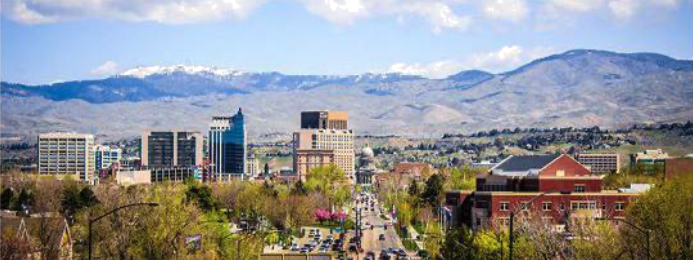
According to Idaho Business Review, "The Treasure Valley is one of the leading markets in the nation in the rapidly growing single-family home built-to-rent market."
Our Thoughts
Rapid population growth and strong employment numbers makes Boise one of the top rental markets in the country. In a recent roundtable with Idaho housing experts and elected officials from across the Treasure Valley, Eric Allen of Zonda (formerly Metrostudy/Meyers), shared: “In 2019, there was an 11,600 net job increase in the Boise area … Even with COVID, the Boise area had a net increase (in 2020) of 500 jobs.”
Coupled with the rapid population growth, home prices in the Treasure Valley to a point where many families and individuals cannot afford to buy and are looking instead to rent. This has created a strong and competitive rental market with low vacancies and historically high rent prices. Check out the article below by Catie Clark from the Idaho Business Review.
Original Article from Idaho Business Review
By: Catie Clark February 2, 2021 Idaho Business Review
The Treasure Valley is one of the leading markets in the nation in the rapidly growing single-family home built-to-rent market. The reasons behind this was one of the major topics of a Jan. 28 virtual roundtable on family rentals, held by the Idaho district council of the Urban Land Institute.
The hour-and-a-half roundtable hosted Idaho housing experts and Treasure Valley elected officials. These included Eric Allen of Zonda (formerly Metrostudy/Meyers), a housing industry research firm; Adam Ducker of Robert Charles Lesser & Co. real estate advisors and Bill Truax of developer Galena Opportunity Inc. The public officials present were Elaine Clegg, president of the City of Boise City Council, Ada County Commissioner Kendra Kenyon and Commissioner Alexis Pickering of the Ada County Highway Department.
The experts came loaded with data on growth, wages, housing inventory, affordability and family demographics. When those data were assembled, they showed why there is increasing demand for SFH rentals in the Treasure Valley.
Allen presented employment and housing numbers showing the growth of the region and the decline of housing inventory. He noted the area’s rapid growth in jobs. “In 2019, there was an 11,600 net job increase in the Boise area … Even with COVID, the Boise area had a net increase (in 2020) of 500 jobs.” Allen explained that since the arrival of the pandemic in March, the local unemployment rate has recovered to 4.9%, which falls into the 4.5%-to-5% range that economists consider a fully employed job market.
Hand-in-hand with job growth is the overall population growth of the region, according to U.S. Census Bureau numbers: “The population has increased 25.4% since 2010 … It is projected to increase 11.4% more between 2020 and 2025.” The data also reveal that a lot of the people who move to the Boise area are coming from high-cost areas like Seattle or California.
Rephrased as a sound bite, the Treasure Valley has jobs and people move here to get them.
After presenting the growth metric, Allen moved on to the historic lack of inventory for existing homes in the Treasure Valley. “There are less than 200 homes for sale right now. There is nothing to buy.”
The number of new homes being built is also at low levels. “In 2006, (the number of new homes) was 2,250,” Allen remarked. “For 2021, it’s 1,200.” He added that the inventory of finished vacant homes is approximately only 15% of the total number of homes for sale. Allen’s point was that new homes are not being built fast enough to meet the demands of regional growth.
Allen’s data showed that most of those new homes were priced above $400,000. Existing homes were also selling at record high prices, with the consequence that there is essentially no inventory of lower-priced homes. He noted that along with a low home inventory, the inventory of ready-to-build lots was also low, which contributed to the rise in the cost of land.
“The median price of detached SFHs in Ada County is $429,000 and in Canyon County, it’s $347,700,” Allen said. “The median income in Ada is (approximately) $69,000 and $54,000 in Canyon County … But the income threshold to buy a new home is $101,000 in Canyon County and $121,000 in Ada.”
Ducker’s presentation dealt with more than just SFH rentals, but his data underscored the economics of why more families are renting. Ducker added demographic data on renters: “One-third of renters (in the United States) are families.” A family was a household with at least one dependent minor. “Over the next decade, as millennials have kids, family renters will have 8% growth … the growth market for family households is in the millennial generation.”
Ducker put the pieces together to show the growing demand for family rentals: “The switch to rentals for family-aged households has been strong over the last decade.” He touched on how housing economics in the Treasure Valley was forcing more families to rent rather than buy a home. There were multiple financial barriers for millennial families, including that over 50% could not afford a down payment.
Ducker’s data showed that, even when renting, families gravitated toward housing with more room: “In Boise, 59% of family renters are renting a single-family home, 7% are renting a single-family detached home and the rest are in apartments.”
The picture presented at the roundtable was clear: Young families are being squeezed out of the market to buy a house, yet these families still prefer the amenity of space that a SFH provides. The combination of these forces is behind the Treasure Valley’s rapid growth in built-to-rent single-family homes.
Author
System










